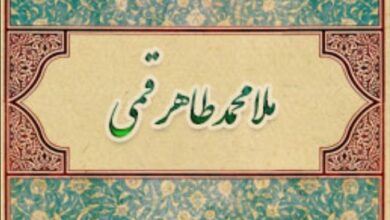The lightening strike: al-shihab al-thaqib by Sayyid Dildar Ali Nasirabadi – Dr. Sajjad Rizvi
Sufis had been recipients of court patronage and constituted a clear threat to claims of clerical authority articulated by the Usulis and required both a political and an intellectual response. Sayyid Dildar ʿAli (d. 1820)’s main work in this endeavour was al-shihab al-thaqib [the lightening strike], again written in Arabic for scholars and dedicated to his patron Sarfaraz al-Dawla Hasan Riza Khan. The text begins with an eloquent proemium in rhyming prose (sajʿ) to demonstrate his ability in Arabic.
He laments the fact that people are turning to Sufi shaikhs, away from the teachings of the Prophet and his successors who are the true authorities and proofs of God. To this end, he cites two themes of anti-Sufi writing well attested in Safavid works. First, the Caliphs in early Islam had promoted Sufis and philosophers to turn people away from the family of the Prophet. He cites the example of the ʿAbbasid Caliph al-Maʾmun (d. 833) who tried to humiliate the eighth Shiʿi Imam ʿAli al-Rida (d. 818) by setting up disputations with theologians and philosophers, using “heresy” to create discord and strife and distract people from the Imams. Sufism was thus a conspiracy to destroy Shiʿism.
Second, the Imams themselves had condemned Sufis as “representatives of Satan”, and had condemned philosophers as corruptors of the people. The very survival of Shiʿism was only due to the diligence and courage of the “true ʿulama” who had opposed Sufis and philosophers and “made their heresy and unbelief” clear to the community. It is the scholars who had, and have, the authority to condemn heresy and provide guidance for the people. Since the ʿulama are arbiters of the true faith, they have the authority and obligation to fight against heresy. It is therefore clear that Sayyid Dildar ʿAli’s argument is concerned with bolstering his own authority, and that of his class of jurists opposed to Sufism.
In the Safavid period, with the work in particular of Mulla Tahir Qummi (d. 1098/1688), one discerns this connection between the illegitimacy of Sufism and philosophy, especially because the latter entails an acceptance of the doctrine of being espoused by the former – and this is clear in al-Fawaʾid al-diniya [Religious Arguments] and Hikmat al-ʿarifin [Philosophy of the mystics]. In these texts, the doctrine of the unity of being (wahdat al-wujud) espoused by the Sunni Sufi Ibn ʿArabi (d. 1240) is condemned in particular – and it is instructive that Sayyid Dildar ʿAli spends most of his time delegitimising this doctrine after a careful reformulation of it.
Al-Shihab al-thaqib is divided into four sections and a conclusion.
The first section, comprising eight chapters, examines the doctrine of being as expressed by Sufis, philosophers and theologians and is a rational consideration of their argument, designed to show that the Sufi position on the unity of being, that all that exists is a singular reality whose referent is ultimately God, is not only intellectually indefensible and demonstrably false (in the standard Aristotelian sense of proof) but also confused.
The second section, divided into six chapters, examines the scriptural texts adduced by Sufis, including Shiʿi Sufis like Sayyid Haidar Amuli (d. 1385), whose ideas and works were popular in India, in favour of the doctrine of the unity of being. Sayyid Dildar ʿAli’s strategy here is not only to draw into question the reliability and probity of these texts, which in many cases of sayings attributed to the Prophet and the Imams are questionable in their ‘authenticity’ but also to raise the hermeneutical problem of how one ought to read and make sense of them. Where the texts are indisputable, such as Qurʾanic verses and some of the hadith, the argument that draws upon them to prove unity of being is disputed and disproved.
The third section then moves onto claims made by Sufis. It is divided into two parts. The first disputes the validity of claims of inner revelation: Sufis claimed that they understood reality and could even verify texts through some process of inspiration or even revelation known as kashf. Deconstructing the notion of kashf and the claims and statements of famous (Sunni) Sufis of the past is an important element of his method in this section. Secondly, it could be taken as an indirect critique of Akhbari methodology since their thinkers, such as Shaikh Yusuf al-Bahrani (d. 1772), claimed to use kashf to verify the authenticity of sayings of the Prophet and the Imams. Part of the critique of kashf relates to the implication that it suggests a shortcoming on the part of the Prophet and the Imams – surely, as representatives of God, they should have informed their community of the truth of things. Their inability to do so is therefore shown up by the claims of Sufis to “know better”.
The second part of this section relates to the “innovations of Sufis”, their embrace of music and dance as ritual practice – an important established theme of Safavid anti-Sufi texts – and their socially transgressive promotion of libertinism. A common feature of heretication, clearly manifest in anti-Sufi texts as early as the medieval period, is the accusation of sexual licentiousness.
The final aspect of this section relates to the “numerous sects’” among Sufis. Consistent with heresiographical method, Sayyid Dildar ʿAli’s enumeration of the sects among Sufis – he draws upon earlier texts such as Hadiqat al-Shiʿa [Garden of the Shiʿa] from the middle of the seventeenth century – is designed to show that if these people were so correct about their vision of reality, why did they disagree so much among themselves?
The fourth section is an attempt to respond to calumnies projected by Sufis against the jurists and an attempt at refuting them.
Divided into six chapters, the conclusion makes it clear why Sayyid Dildar ʿAli believes it necessary to write a condemnation of Sufism. First, he has a duty to enjoin good and forbid evil (an important obligation in Shiʿi theology) and as he sees Sufism as an evil, he is obliged to warn people. Second, he has a duty to warn people to steer clear of gatherings of innovation (bidʿa): the social popularity of Sufi practice in the towns of Awadh necessitates this warning. Third, since it is prohibited to follow the enemies of the faith – and here he means Sunni Sufis, who distract people from following the Imams and their representatives the Shiʿi jurists – he must warn them of this prohibition. Fourth, it is permissible, and indeed required, to curse innovators – and Sufis, as the texts cited by him from the Imams make clear, are innovators. Fifth, belief in the unity of being is clear heresy and must be proclaimed as such. Finally, as a jurist with a theological and moral obligation, he must call people to repent – once people are convinced of the evil of Sufi ideas and practices, they can repent and return to the fold of the faith.
He follows up this text with a Persian version that is shorter entitled Risala-yi radd-i mazhab-i sufiya [Refutation of the religion of the Sufis].
While there is much in it that follows earlier Safavid patterns, Sayyid Dildar ʿAli makes his own contributions, especially in his exposition of the philosophy of being in the first section, demonstrating his skill in the tradition of Mulla Sadra (d. 1635), on whose Sharh al-hidaya [Commentary on the guidance], the main philosophical text of the dars-i nizami, he wrote a marginalia.
What is remarkable about this anti-Sufism is its condemnation of the doctrine of the unity of being. While this focus is clear in Safavid sources, there are also particular reasons for this, deriving from his context.
First, we know that the school of Ibn ʿArabi and the doctrine of the unity of being was the dominant idea of Awadh Sufis, both among the Chishtiya and others, including major figures who were associated with the court. Shah ʿAli Akbar Husaini Mawdudi Chishti of Faizabad (d. 1210/1795), who led his own Friday prayers (at a shrine in Ayodhya) that were frequented by Shiʿa and patronised by the vizier Sayyid Hasan Riza Khan and Shah Khairullah Naqshbandi, was one such prominent individual.
Mawdudi was a descendent of the founder of the Chishti order, a sayyid and known to have tafzili views (preferring ʿAli over Abu Bakr on the issue of succession to the Prophet). Hence, he was seen as a philo-Shiʿi, and a proponent not only of the use of devotional music but also an ardent defender of the monism of Ibn ʿArabi. He was an influential person at court.
Implicitly the attack was on the Shah Wali Allah tradition, associated with the major theological figure of Delhi whose influence extended to Awadh and who was also known to have penned anti-Shiʿi polemics. An attack on the unity of being was, therefore, intended to discredit and delegimitise such claims to religious authority.
Second, the doctrine of the unity of being was popular among the Sunni ʿulama of Farangi Mahall who had traditionally provided the services of scholarship and justice for the Awadh state, and was therefore an attack on their legitimacy. Precursors of this are clear in the biographical sources that claim Sayyid Dildar ʿAli bettering both ʿAbd ʿAli Bahr al-ʿulum and Mulla Hasan in debate.
Third, anti-Sufism was a major theme in the thought of Sayyid Dildar ʿAli’s teachers in Iraq – indeed, the son of Bihbahani wrote perhaps the major Persian anti-Sufi polemic of the period, the Risala-yi khayratiya.
Finally, the position on unity of being was also an attempt to enhance his own theological method since it was a doctrine that was already popular among Shiʿi scholars both in Iran and India. As such, he was drawing a line under the Safavid tradition that was open to such speculative metaphysics and mysticism and, instead, trying to return to a more pristine Shiʿi theology.
Download arabic manuscript of al-shihab al-thaqib
Source: Sajjad Rizvi, “Faith Deployed for a New Shiʿi Polity in India”, Journal of the Royal Asiatic Society, Vol. 24 (3): Isna ‘Ashari and Isma‘ili Shi‘ism: from South Asia to the Indian Ocean, July 2014, pp. 363 – 380.



